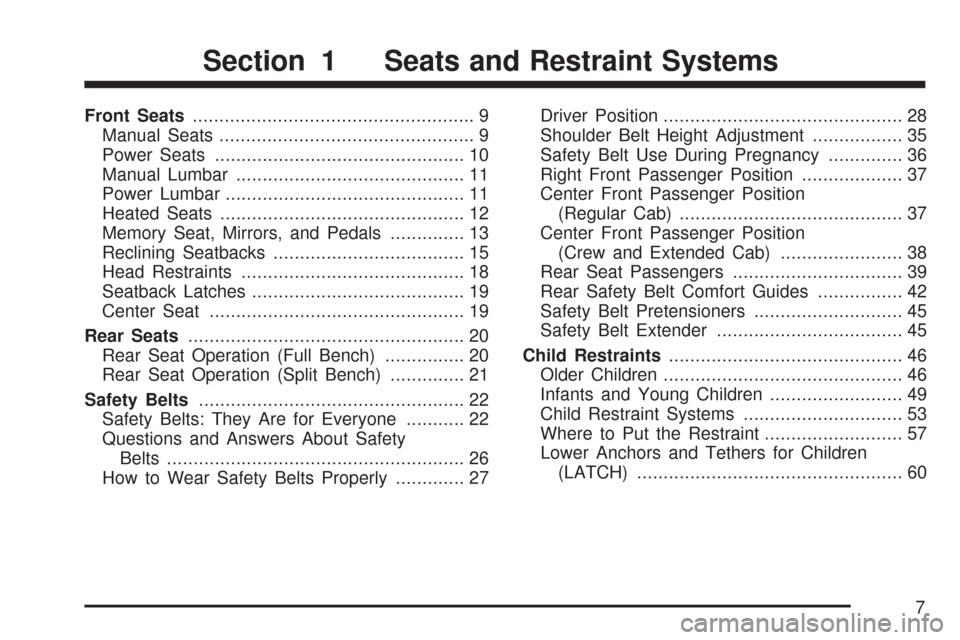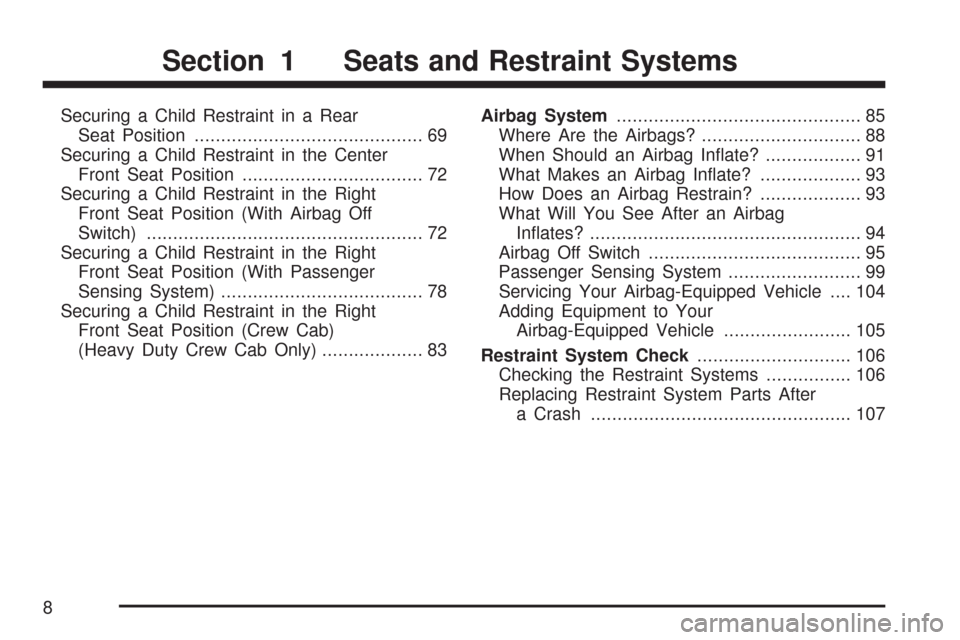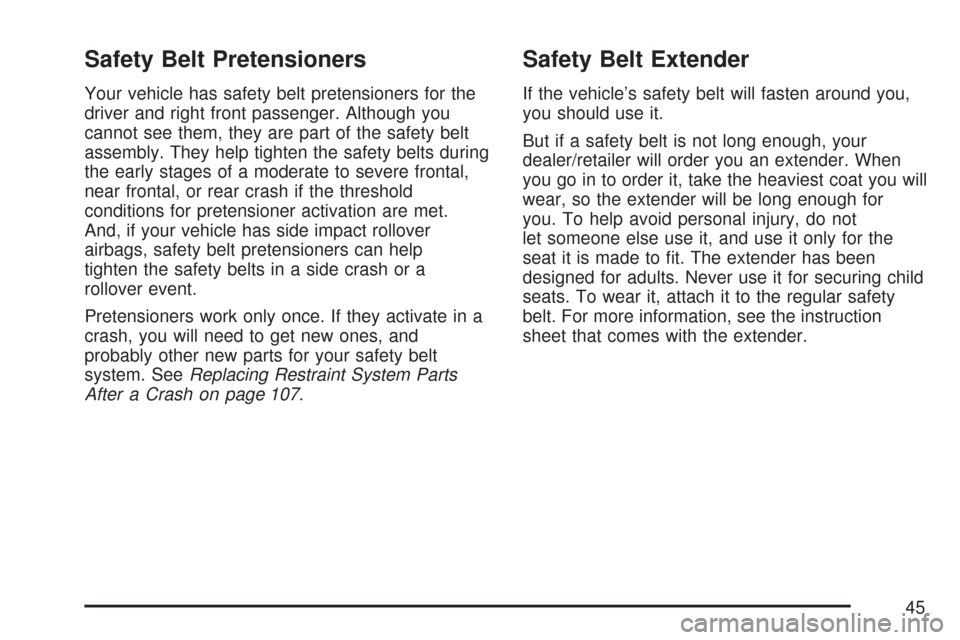Page 1 of 684

Seats and Restraint Systems
....................... 7
Front Seats
.............................................. 9
Rear Seats
............................................. 20
Safety Belts
............................................ 22
Child Restraints
...................................... 46
Airbag System
........................................ 85
Restraint System Check
....................... 106
Features and Controls
.............................. 109
Keys
..................................................... 111
Doors and Locks
.................................. 120
Windows
............................................... 126
Theft-Deterrent Systems
....................... 129
Starting and Operating Your Vehicle
..... 134
Mirrors
.................................................. 171
OnStar
®System
................................... 182
Universal Home Remote System
.......... 186
Storage Areas
...................................... 198
Sunroof
................................................ 202Instrument Panel
....................................... 205
Instrument Panel Overview
................... 208
Climate Controls
................................... 236
Warning Lights, Gages, and
Indicators
.......................................... 248
Driver Information Center (DIC)
............ 269
Audio System(s)
................................... 302
Driving Your Vehicle
................................. 375
Your Driving, the Road, and Your
Vehicle
.............................................. 376
Towing
................................................. 441
Service and Appearance Care
.................. 485
Service
................................................. 488
Fuel
...................................................... 490
Checking Things Under the Hood
......... 498
Rear Axle
............................................. 540
Four-Wheel Drive
.................................. 541
Front Axle
............................................ 543
2007 Chevrolet Silverado Owner ManualM
1
Page 7 of 684

Front Seats..................................................... 9
Manual Seats................................................ 9
Power Seats............................................... 10
Manual Lumbar........................................... 11
Power Lumbar............................................. 11
Heated Seats.............................................. 12
Memory Seat, Mirrors, and Pedals.............. 13
Reclining Seatbacks.................................... 15
Head Restraints.......................................... 18
Seatback Latches........................................ 19
Center Seat................................................ 19
Rear Seats.................................................... 20
Rear Seat Operation (Full Bench)............... 20
Rear Seat Operation (Split Bench).............. 21
Safety Belts.................................................. 22
Safety Belts: They Are for Everyone........... 22
Questions and Answers About Safety
Belts........................................................ 26
How to Wear Safety Belts Properly............. 27Driver Position............................................. 28
Shoulder Belt Height Adjustment................. 35
Safety Belt Use During Pregnancy.............. 36
Right Front Passenger Position................... 37
Center Front Passenger Position
(Regular Cab).......................................... 37
Center Front Passenger Position
(Crew and Extended Cab)....................... 38
Rear Seat Passengers................................ 39
Rear Safety Belt Comfort Guides................ 42
Safety Belt Pretensioners............................ 45
Safety Belt Extender................................... 45
Child Restraints............................................ 46
Older Children............................................. 46
Infants and Young Children......................... 49
Child Restraint Systems.............................. 53
Where to Put the Restraint.......................... 57
Lower Anchors and Tethers for Children
(LATCH).................................................. 60
Section 1 Seats and Restraint Systems
7
Page 8 of 684

Securing a Child Restraint in a Rear
Seat Position........................................... 69
Securing a Child Restraint in the Center
Front Seat Position.................................. 72
Securing a Child Restraint in the Right
Front Seat Position (With Airbag Off
Switch).................................................... 72
Securing a Child Restraint in the Right
Front Seat Position (With Passenger
Sensing System)...................................... 78
Securing a Child Restraint in the Right
Front Seat Position (Crew Cab)
(Heavy Duty Crew Cab Only)................... 83Airbag System.............................................. 85
Where Are the Airbags?.............................. 88
When Should an Airbag In�ate?.................. 91
What Makes an Airbag In�ate?................... 93
How Does an Airbag Restrain?................... 93
What Will You See After an Airbag
In�ates?................................................... 94
Airbag Off Switch........................................ 95
Passenger Sensing System ......................... 99
Servicing Your Airbag-Equipped Vehicle.... 104
Adding Equipment to Your
Airbag-Equipped Vehicle........................ 105
Restraint System Check............................. 106
Checking the Restraint Systems................ 106
Replacing Restraint System Parts After
a Crash................................................. 107
Section 1 Seats and Restraint Systems
8
Page 42 of 684
To unlatch the belt, push the button on the buckle.
Rear Safety Belt Comfort Guides
Rear shoulder belt comfort guides may provide
added safety belt comfort for older children
who have outgrown booster seats and for some
adults. When installed on a shoulder belt, the
comfort guide positions the belt away from
the neck and head.
There is one guide for each outboard passenger
position in the rear seat. Here is how to install
a comfort guide to the shoulder belt:
1. Remove the guide from its storage clip on the
interior body.
42
Page 45 of 684

Safety Belt Pretensioners
Your vehicle has safety belt pretensioners for the
driver and right front passenger. Although you
cannot see them, they are part of the safety belt
assembly. They help tighten the safety belts during
the early stages of a moderate to severe frontal,
near frontal, or rear crash if the threshold
conditions for pretensioner activation are met.
And, if your vehicle has side impact rollover
airbags, safety belt pretensioners can help
tighten the safety belts in a side crash or a
rollover event.
Pretensioners work only once. If they activate in a
crash, you will need to get new ones, and
probably other new parts for your safety belt
system. SeeReplacing Restraint System Parts
After a Crash on page 107.
Safety Belt Extender
If the vehicle’s safety belt will fasten around you,
you should use it.
But if a safety belt is not long enough, your
dealer/retailer will order you an extender. When
you go in to order it, take the heaviest coat you will
wear, so the extender will be long enough for
you. To help avoid personal injury, do not
let someone else use it, and use it only for the
seat it is made to �t. The extender has been
designed for adults. Never use it for securing child
seats. To wear it, attach it to the regular safety
belt. For more information, see the instruction
sheet that comes with the extender.
45
Page 46 of 684
Child Restraints
Older Children
Older children who have outgrown booster seats
should wear the vehicle’s safety belts.
Q:What is the proper way to wear safety
belts?
A:An older child should wear a lap-shoulder belt
and get the additional restraint a shoulder belt
can provide. The shoulder belt should not
cross the face or neck. The lap belt should �t
snugly below the hips, just touching the
top of the thighs. It should never be worn over
the abdomen, which could cause severe or
even fatal internal injuries in a crash.
According to accident statistics, children are safer
when properly restrained in the rear seating
positions than in the front seating positions.
In a crash, children who are not buckled up can
strike other people who are buckled up, or can be
thrown out of the vehicle. Older children need
to use safety belts properly.
46
Page 47 of 684
{CAUTION:
Never do this.
Here two children are wearing the same
belt. The belt cannot properly spread the
impact forces. In a crash, the two children
can be crushed together and seriously
injured. A belt must be used by only one
person at a time.
Q:What if a child is wearing a lap-shoulder
belt, but the child is so small that the
shoulder belt is very close to the child’s
face or neck?
A:If the child is sitting in a seat next to a
window, move the child toward the center of
the vehicle. Also seeRear Safety Belt
Comfort Guides on page 42. If the child is
sitting in the center rear seat passenger
position, move the child toward the safety belt
buckle. In either case, be sure that the
shoulder belt still is on the child’s shoulder, so
that in a crash the child’s upper body would
have the restraint that belts provide.
47
Page 48 of 684
{CAUTION:
Never do this.
Here a child is sitting in a seat that has a
lap-shoulder belt, but the shoulder part is
behind the child. If the child wears the belt
in this way, in a crash the child might slide
under the belt. The belt’s force would then
be applied right on the child’s abdomen.
That could cause serious or fatal injuries.
Wherever the child sits, the lap portion of the belt
should be worn low and snug on the hips, just
touching the child’s thighs. This applies belt force
to the child’s pelvic bones in a crash.
48